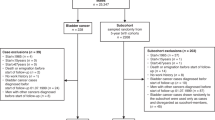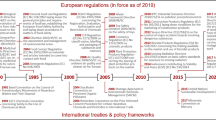Abstract
This study presents and evaluates an expert group's assessment of exposure to carcinogens for defined job categories in Norway's offshore petroleum industry, 1970–2005, to provide exposure information for a planned cohort study on cancer. Three university and five industry experts in occupational hygiene individually assessed the likelihood of exposure to 1836 combinations of carcinogens (n=17), job categories (n=27) and time periods (n=4). In subsequent plenary discussions, the experts agreed on exposed combinations. Agreement between the individual and the panel assessments was calculated by Cohen's κ index. Using the panel assessment as reference, sensitivity and specificity were estimated. The eight experts assessed 63% of the 1836 combinations in plenary, resulting in 265 (14%) convened exposed combinations. Chlorinated hydrocarbons, benzene and inhalation of mineral oils had the highest number of exposed job categories (n=14, 9 and 10, respectively). The job categories classified as exposed to the highest numbers of carcinogens were the mechanics (n=10), derrick workers (n=6) and process technicians (n=5). The agreement between the experts’ individual assessments and the panel assessment was κ=0.53–0.74. The sensitivity was 0.55–0.86 and specificity 0.91–0.97. For these parameters, there were no apparent differences between the university experts and the industry experts. The resulting 265 of 1836 possible exposure combinations convened as “exposed” by expert assessment is presented in this study. The experts’ individual ratings highly agreed with the succeeding panel assessment. Correlation was found between years of experience of the raters and agreement with the panel. The university experts and the industry experts’ assessments had no apparent differences. Further validation of the exposure assessment is suggested, such as by new sampling data or observational studies.
This is a preview of subscription content, access via your institution
Access options
Subscribe to this journal
Receive 6 print issues and online access
$259.00 per year
only $43.17 per issue
Buy this article
- Purchase on Springer Link
- Instant access to full article PDF
Prices may be subject to local taxes which are calculated during checkout
Similar content being viewed by others
References
Altman D.G. Practical Statistics for Medical Research. Chapman & Hall/CRC: New York, 1991.
Armstrong B. A simple estimator of minimum detectable relative risk, sample size, or power in cohort studies. Am J Epidemiol 1987: 126: 356–358.
Benke G., Sim M., Forbes A., and Salzberg M. Retrospective assessment of occupational exposure to chemicals in community-based studies: validity and repeatability of industrial hygiene panel ratings. Int J Epidemiol 1997: 26: 635–642.
Benke G., Sim M., Fritschi L., Aldred G., Forbes A., and Kauppinen T. Comparison of occupational exposure using three different methods: hygiene panel, job exposure matrix (JEM), and self reports. Appl Occup Environ Hyg 2001: 16: 84–91.
Boers D., Zeegers M.P.A., Swaen G.M., Kant I.J., and van den Brandt P.A. The influence of occupational exposure to pesticides, polycyclic aromatic hydrocarbons, diesel exhaust, metal dust, metal fumes, and mineral oil on prostate cancer: a prospective cohort study. Occup Environ Med 2005: 62: 531–537.
Cancer Registry of Norway. Cancer in Norway 2005. Cancer Incidence, Mortality, Survival and Prevalence in Norway. Cancer Registry of Norway: Oslo, 2006 Available from URL: http://www.kreftregisteret.no/forekomst_og_overlevelse_2005/cin2005.pdfaccessed 2 March 2007.
Cottle M.K.W., and Guidotti T.L. Process chemicals in the oil and gas industry: potential occupational hazards. Toxicol Ind Health 1990: 6: 41–56.
Davidson R.G., Evans M.J., Hamlin J.W., and Saunders K.J. Occupational hygiene aspects of the use of oil-based drilling fluids. Ann Occup Hyg 1988: 32: 325–332.
Eide I. A review of exposure conditions and possible health effects associated with aerosol and vapour from low-aromatic oil-based drilling fluids. Ann Occup Hyg 1990: 34: 149–157.
Elliott D., and Grieve A.M. The offshore oil and gas industry. In: Harrington JM editor. Recent Advances in Occupational Health. Churchill Livingstone: Edinburgh, 1987, 21–36.
Flegal K.M., Brownie C., and Haas J.D. The effects of exposure misclassification on estimates of relative risk. Am J Epidemiol 1986: 123: 736–751.
Fleiss J.L. Statistical Methods for Rates and Proportions. Wiley: New York, 1981, 212–236.
Gardner R. Overview and characteristics of some occupational exposures and health risks on offshore oil and gas installations. Ann Occup Hyg 2003: 47: 201–210.
Glass D.C., Adams G.G., Manuell R.W., and Bisby J.A. Retrospective exposure assessment for benzene in the Australian petroleum industry. Ann Occup Hyg 2000: 44: 301–320.
Grieve A. Oil: toxicity of drilling mud. Occup Health (London) 1988: 40: 736–739.
Gun R.T., Pratt N., Ryan P., and Roder D. Update of mortality and cancer incidence in the Australian petroleum industry cohort. Occup Environ Med 2006: 63: 476–481.
Hawkins N.C., and Evans J.S. Subjective estimation of toluene exposures: a calibration study of industrial hygienists. Appl Ind Hyg 1989: 4: 61–68.
Health and Safety Executive. Occupational Exposure to Benzene, Toluene, Xylene and Ethylbenzene during Routine Offshore Oil and Gas Production Operations. HSE Offshore Technology Report OTO 1999 088. Health and Safety Executive: London, 2000a.
Health and Safety Executive. Drilling Fluids Composition and use within the UK Offshore Drilling Industry HSE offshore Technology Report — OTO 1999 089. Health and Safety Executive: London, 2000b.
Hudgins C.M. Chemical Usage in North Sea Oil and Gas Production and Exploration Operations. Petrotech Consultants Inc.: Houston, p. 622.24:665.6:66, 1991.
IARC. IARC Monographs on the Evaluation of Carcinogenic Risks to Humans. International Agency for Research on Cancer: Lyon, 2006 Available from: URL: http://monographs.iarc.fraccessed 22 October 2006..
The International Association of Oil & Gas Producers. UK. 2006 Available from URL: http://www.ogp.org.ukaccessed 22 October 2006.
James R.W., Schei T., Navestad P., Geddes T.A., Nelson M.G., and Webster D. Improving the working environment and drilling economics through better understanding of oil-based drilling fluid chemistry. SPE Drilling Completion 2000: 15: 254–260.
Kirkeleit J., Riise T., Bråtveit M., and Moen B.E. Benzene exposure on a crude oil production vessel. Ann Occup Hyg 2006: 50: 123–129.
van Loon A.J., Kant I.J., Swaen G.M., Goldbohm R.A., Kremer A.M., and van den Brandt P.A. Occupational exposure to carcinogens and risk of lung cancer: results from the Netherlands cohort study. Occup Environ Med 1997: 54: 817–824.
Ministry of Petroleum and Energy. Facts 2006 — the Norwegian Petroleum Sector. Ministry of Petroleum and Energy: Oslo, 2005 Available from URL: http://www.dep.no/filarkiv/278568/Fakta-eng2.pdfaccessed 22 October 2006.
Post W., Kromhout H., Heederik D., Noy D., and Duijzentkunst R.S. Semiquantitative estimates of exposure to methylene chloride and styrene: the influence of quantitative exposure data. Appl Occup Environ Hyg 1991: 6: 197–204.
Rousseau M.C., Straif K., and Siemiatycki J. IARC carcinogen update. Environ Health Perspect 2005: 113: A580–A581.
Siemiatycki J., Richardson L., Straif K., Latreille B., Lakhani R., Campbell S., et al. Listing occupational carcinogens. Environ Health Perspect 2004: 112: 1447–1459.
Smith T.J., Stewart P.A., and Herrick R.F. Retrospective exposure assessment. In: Gardiner K, Harrington JM, editors. Occupational Hygiene, 3rd edn. Blackwell: Oxford, 2005.
Statistics Norway. Principal Figures for Extraction of Crude Oil and Natural Gas 1998–2004 2006, Statistics Norway: Oslo, 2006, Available from URL: http://www.ssb.no/english/subjects/10/06/20/oljev_en/tab-2006-02-28-01-en.htmlaccessed 22 October 2006.
Steinsvåg K., Bråtveit M., and Moen B.E. Exposure to oil mist and oil vapour during offshore drilling in Norway, 1979–2004. Ann Occup Hyg 2006a: 50: 109–122.
Steinsvåg K., Bråtveit M., and Moen B.E. Exposure to carcinogens for defined job categories in Norway's offshore petroleum industry 1970–2005. Occup Environ Med 2006b [E-pub ahead of print].
Steinsvåg K., Bråtveit M., Moen B.E., and Kromhout H. Interrater agreement in the assessment of exposure to carcinogens in the offshore petroleum industry. OccupEnviron Med 2007 [E-pub ahead of print].
Strand L.Å., and Andersen A. Kartlegging av kreftrisiko og årsaksspesifikk dødelighet blant ansatte i norsk offshorevirksomhet. Innsamling av bakgrunnsdata og etablering av kohort [Survey of cancer risk and cause-specific mortality of Norwegian offshore oil industry workers. Collection of background data and establishment of a cohort]. Cancer Registry of Norway: Oslo, 2001.
Teschke K. Exposure surrogates: job–exposure matrices, self-reports, and expert evaluations. In: Nieuwenhuijsen MJ, (Ed.) Exposure assessment in Occupational and Environmental Epidemiology. Oxford University Press: Oxford, 2003, 118–132.
Teschke K., Olshan A.F., Daniels J.L., De Roos A.J., Parks C.G., Schulz M., et al. Occupational exposure assessment in case–control studies: opportunities for improvement. Occup Environ Med 2002: 59: 575–594.
Teschke K., Hertzman C., Dimich-Ward H., Ostry A., Blair J., and Hershler R. A comparison of exposure estimates by worker raters and industrial hygienists. Scand J Work Environ Health 1989: 5: 424–429.
van Tongeren M., Nieuwenhuijsen M.J., Gardiner K., Armstrong B., Vrijheid M., Dolk H., et al. A job–exposure matrix for potential endocrine-disrupting chemicals developed for a study into the association between maternal occupational exposure and hypospadias. Ann Occup Hyg 2002: 46: 465–477.
Zeegers M.P.A., Swaen G.M.H., Kant I., Goldbohm R.A., and van den Brandt P.A. Occupational risk factors for male bladder cancer: results from a population based case cohort study in the Netherlands. Occup Environ Med 2001: 58: 590–596.
Acknowledgements
The Norwegian Oil Industry Association (OLF) and the Norwegian Research Council funded this study. Special thanks to project consultant Berit Larsen, University of Bergen, for taking care of the practical issues when arranging the expert meeting.
Author information
Authors and Affiliations
Corresponding author
Rights and permissions
About this article
Cite this article
Steinsvåg, K., Bråtveit, M., Moen, B. et al. Expert assessment of exposure to carcinogens in Norway's offshore petroleum industry. J Expo Sci Environ Epidemiol 18, 175–182 (2008). https://doi.org/10.1038/sj.jes.7500578
Received:
Accepted:
Published:
Issue Date:
DOI: https://doi.org/10.1038/sj.jes.7500578
Keywords
This article is cited by
-
Benzene exposure and risk of lymphohaematopoietic cancers in 25 000 offshore oil industry workers
British Journal of Cancer (2015)
-
Occupational exposure levels to benzene in Italy: findings from a national database
International Archives of Occupational and Environmental Health (2011)
-
Expert assessment of exposure to carcinogens in Norway's offshore petroleum industry
Journal of Exposure Science & Environmental Epidemiology (2008)



